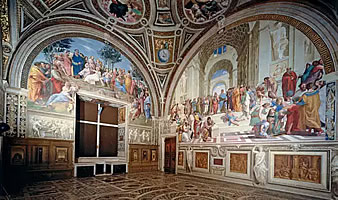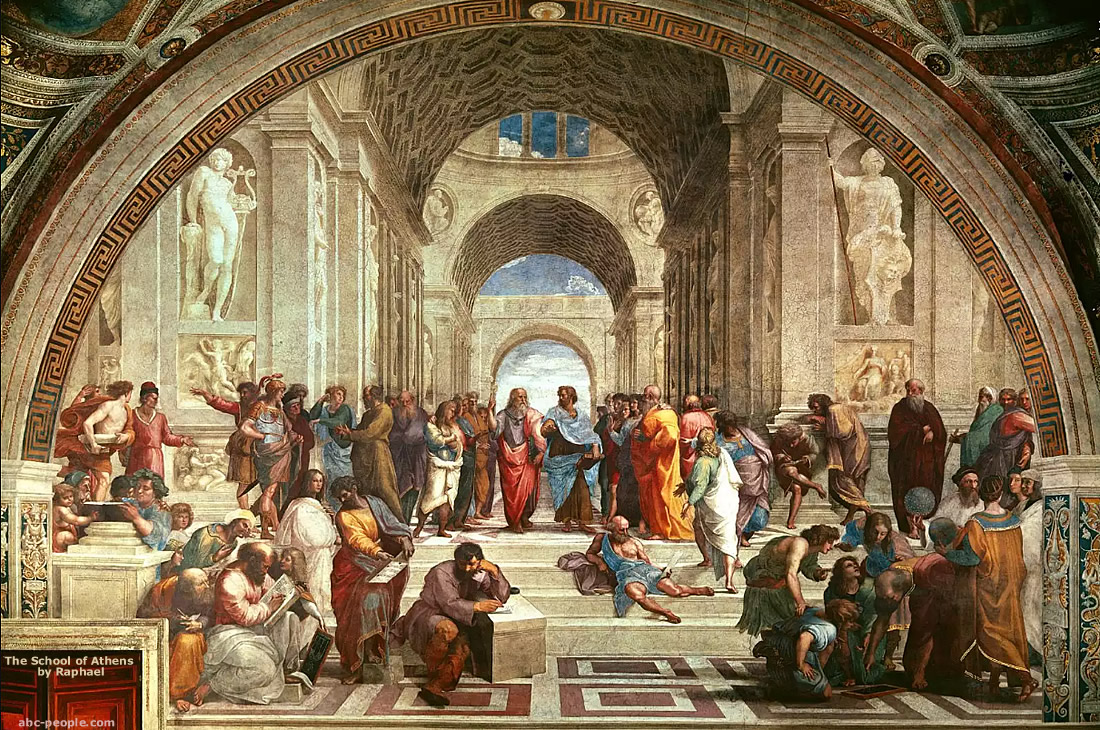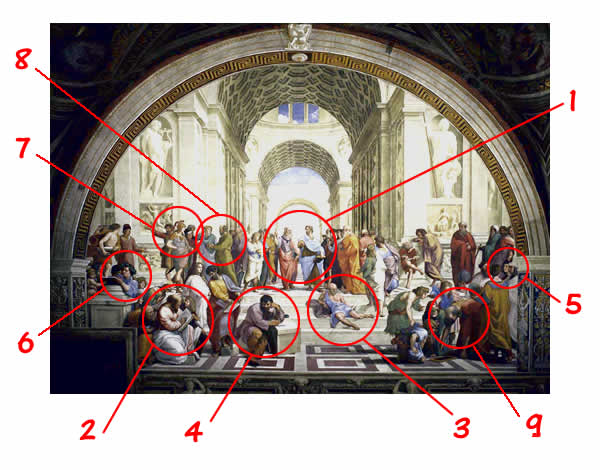| Raphael's
Masterpieces |
|
The
School of Athens |
||
|
Who
is who on the fresco? |
Why
did Raphael paint the School of Athens? |
The
mystery surrounding the Fresco |
| |
|
|
| Raphael
Sanzio |
Who painted the "School of Athens"? The School of Athens (Italian: Scuola di Atene) is one of the most famous frescoes by the Italian Renaissance artist Raphael. It was painted between 1509 and 1511 as a part of Raphael's commission to decorate the rooms now known as the Stanze di Raffaello, in the Apostolic Palace in the Vatican. The Stanza della Segnatura was the first of the rooms to be decorated, and The School of Athens, representing Philosophy, was probably the second painting to be finished there, after La Disputa (Theology) on the opposite wall, and the Parnassus (Literature). The picture has long been seen as "Raphael's masterpiece and the perfect embodiment of the classical spirit of the Renaissance". [Wikipedia] The fresco "School of Athens" itself includes 21 distinct figures set against a backdrop of a school. The figures are engaged in conversation, work or games. All of the figures are male and are believed to represent all significant Greek philosophers. The fresco also includes images of statues within the school displayed within the school. One statue is Apollo, the Greek god of light, archery and music, holding a lyre. The other statue is Athena, the Greek goddess of wisdom, shown in her Roman form as Minerva. The building itself is shown in a cross-shape with the figures in the foreground and the interior receding behind them. The figures are scattered across steps and walkways within the school and the fresco is framed with an arch decorated with arabesque swastikas. The fresco measures 200 inches by 300 inches with a tondo above depicting a female figure with a putti stating “Seek Knowledge of Causes.” |
|
|

|
The
School of Athens
Who is who on the fresco?
They
look to tired critics like mere busts Anthony Lombardy |
Why did Raphael paint the School of Athens? In 1510 and 1511, Rafael painted the School of Athens in order to depict philosophy as one of the four branches of knowledge in a series of frescoes on the walls of the Apostolic Palace in Vatican City. Pope Julius II commissioned the paintings, but it is not known whether he gave Rafael any specific instructions concerning the themes of the frescoes. The rooms holding the paintings are known as the Stanze di Rafaello. The four branches of knowledge represented in the frescoes are poetry, law, philosophy and theology. Considered by many art historians to be Rafael's masterpiece, the School of Athens has 21 artists and philosophers in a large court with receding vaults. Above them are statues of the mythological Greek gods Apollo, the god of light and music, and Athena, the goddess of wisdom. Central in the painting are Plato, as a gray-haired old man, and Aristotle, a younger man who is obviously Plato's student. Other philosophers are less identifiable because no historical images of them exist. Figures whose identities historians are fairly certain include Socrates, Euclid, Ptolemy, Pythagoras and Zoroaster. Though these philosophers lived at different times, Rafael assembled them to encompass his overall theme of philosophical knowledge. Rafael also painted himself into the picture as one of the 21 philosophers. |
The
mystery surrounding the Raphael's Fresco "The School of Athens" |
 |
Upon Raphael's submission of his preliminary compositional sketches of the fresco to the church fathers, the Bishop is alleged to have inquired as to the identity of a woman depicted standing at the bottom (front) and center of a sketch, in the foreground, between the figures of Parmenides and Diogenes, “Who is this woman in the middle?”
“Remove her. Knowledge of her runs counter to the belief of the faithful! Otherwise, the work is acceptable,” cautioned the Vatican's high priest. The Bishop's words struck at the heart of Raphael's original artistic conception. It had been the artist's intention to depict Hypatia standing alone in the center foreground, located, spatially, between the viewers of the fresco and the central figures of Plato and Aristotle, as homage to her unique role, temporally, as guardian and transmitter of their ancient wisdom and inquiring spirit to their intellectual heirs in future eras. |
Yielding to the power of the purse strings, Raphael's initial reaction was simply to omit the figure from his final working drawing, but he then proceeded instead to disguise his original intention as an intimate gesture to his holy patron. In an area which had been vacant in the preliminary compositional sketch, directly behind and between the images of Pythagoras and Parmenides, the artist's final working drawing, the “cartoon” (detail), bears the image of Hypatia, her dark skin recast to a very pale white and her facial features altered to resemble those of the “beloved” nephew of the Pope. Raphael thereby restored Hypatia to a rightful place in his masterpiece among her intellectual peers. While the figure of Hypatia was displaced and disguised, her posture and demeanor were preserved. Unlike almost all of the other characters in the fresco, Hypatia is depicted, not engaged in philosophic inquiry with her peers, but instead directing her gaze out of the painting, towards the viewer standing in front of the fresco. The only other figures so depicted are those of the historian, Diogenes of Laertius, and the artist himself. Raphael thereby symbolizes the roles of the chronicler, the curator, and the artist in projecting, into the future, the intellectual and spiritual thrust of the School of Athens. (Also, whereas the figure of Hypatia was displaced, the figure of Heraclitus is the only major figure in the entire work that was totally absent from Raphael's final working drawing, the “cartoon”, of all the figures in the fresco. In fact, subsequent examination of the fresco confirms that the figure of Heraclitus was painted in on an area of fresh plaster put on after the adjacent figures were completed. This block-like figure plugged up the visual hole, the expanse of marble steps and flooring in front of Plato and Aristotle, left unoccupied by Hypatia's displacement.) Thus,
the effeminate, white-robed figure in Scuola di Atene serves here
to represent the first significant female philosopher, and the last
philosopher, of the ancient age. The pale complexion and juvenile
visage of Pope Julius II's beloved nephew was apparently sufficient
distraction to have prevented the Pope's recognition of Raphael's
representation of Hypatia of Alexandria, an official enemy of the
Church, whose martyrdom at the hands of Nitrian monks had signaled
the death of the classical world. |
 |
One
of the Raphael's Room in Apostolic Palace |
Copies
of the frescoes School of Athens |
References |
|
| -
History of Art: The Western Tradition by Horst Woldemar Janson, Anthony
F. Janson - Giorgio Vasari, "Raphael of Urbino", in Lives of the Artists, vol. I - M. Smolizza, ‘’Rafael y el Amor. La Escuela de Atenas como protréptico a la filosofia’’, in ‘Idea y Sentimiento. Itinerarios por el dibujo de Rafael a Cézanne’, Barcelona, 2007. - Brown, Clare & Evans, Mark. Raphael: Cartoons and Tapestries for the Sistine Chapel. V & A Publishing 2010 - Chapman, Hugo, et al. Raphael: From Urbino to Rome. National Gallery Company Ltd, 2008 - De Vecchi, Pier Luigi. Raphael. Abbeville Press Inc. , 2003 - Jones, R. Raphael. Yale University Press, 1987 - Talvacchia, Bette. Raphael. Phaidon Press Ltd, 2007 - Whistler, Catherine. Michelangelo and Raphael Drawings. Ashmolean Museum, 1990 - Hypatia at Encyclopædia Britannica. - Gardner Hale, The Technique of Fresco Painting, New York, Dover, 1966 (Dover reprint of: Gardner Hale, Fresco Painting, William Edwin Rudge, New York, 1933). - Arnold Nesselrath, Raphael’s School of Athens (Recent Restorations of the Vatican Museums, Vol. 1), Vatican City State, 1997. |
|
|
| Copyright
© 2004 abc-people.com Design and conception BeStudio © 2014-2025 |






